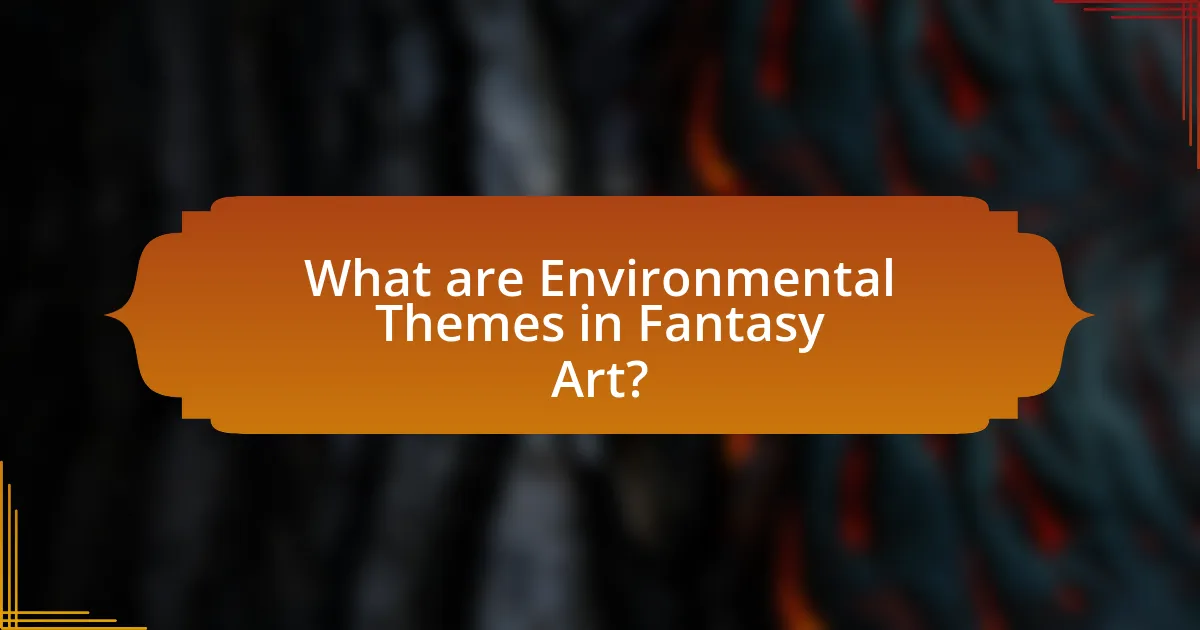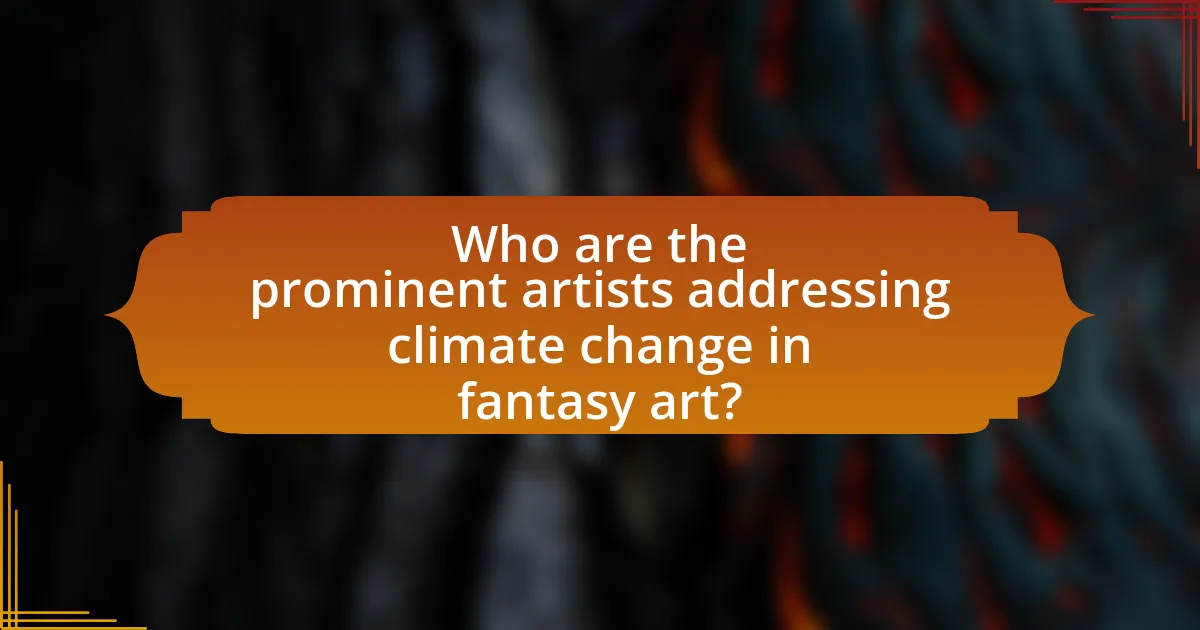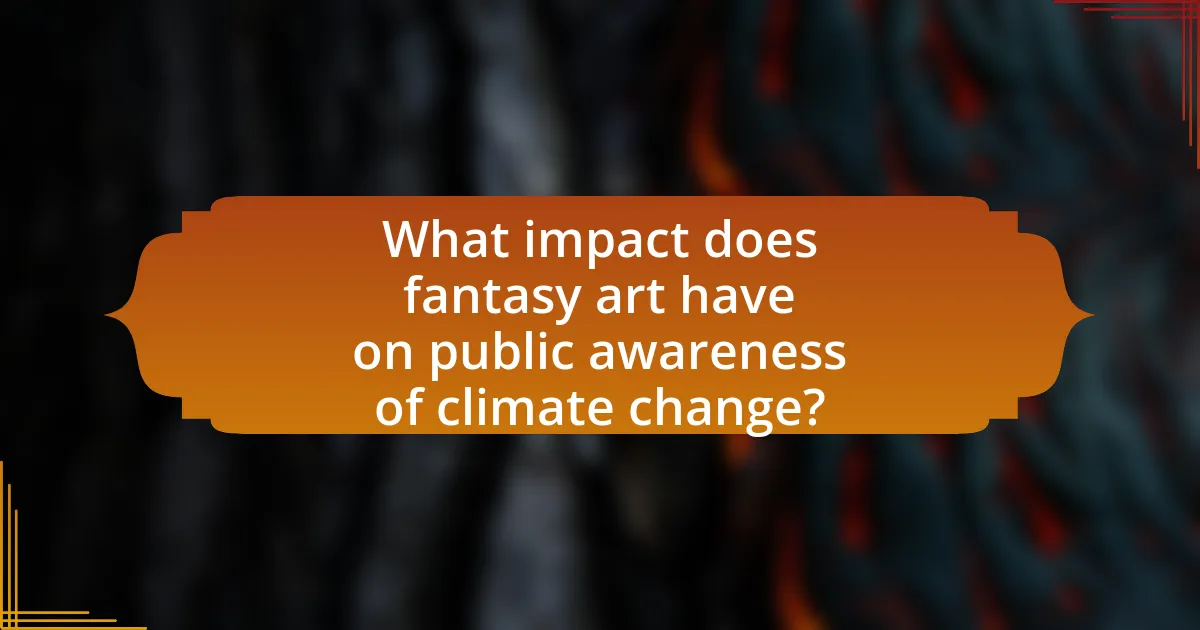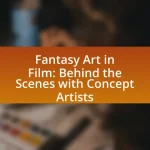Environmental themes in fantasy art focus on the representation of nature, ecosystems, and the effects of climate change within imaginative contexts. Artists such as Brian Froud and Julie Bell illustrate the beauty and fragility of the environment, often depicting altered landscapes and endangered species to raise awareness about ecological issues. The article explores how visual elements, color palettes, and storytelling techniques in fantasy art engage audiences and provoke emotional responses regarding climate change. It also highlights the challenges artists face in balancing creativity with activism and the impact of their work on public perception and environmental advocacy.

What are Environmental Themes in Fantasy Art?
Environmental themes in fantasy art encompass the portrayal of nature, ecosystems, and the impact of climate change within imaginative settings. Artists often depict lush landscapes, mythical creatures, and fantastical environments that reflect real-world ecological issues, such as deforestation, pollution, and climate change. For instance, works by artists like Brian Froud and Julie Bell illustrate the beauty of nature while simultaneously highlighting its fragility, thus raising awareness about environmental conservation. This integration of environmental themes serves to engage viewers in discussions about sustainability and the importance of protecting our planet.
How do artists incorporate climate change into their fantasy art?
Artists incorporate climate change into their fantasy art by depicting altered landscapes, endangered species, and the consequences of environmental degradation. For instance, they often illustrate dystopian worlds where rising sea levels have submerged cities or where forests are barren due to deforestation. This visual storytelling serves to raise awareness about climate issues and provoke emotional responses from viewers. Research shows that art can effectively communicate complex themes, making the abstract concept of climate change more relatable and urgent. By using fantastical elements, artists can highlight real-world environmental challenges, encouraging audiences to reflect on their impact on the planet.
What visual elements represent environmental issues in fantasy art?
Visual elements that represent environmental issues in fantasy art include depictions of nature, pollution, and climate change effects. Artists often illustrate lush landscapes to highlight the beauty of the environment, contrasting them with images of destruction, such as deforestation or polluted waters, to emphasize the impact of human actions. Additionally, the use of mythical creatures or altered ecosystems can symbolize the fragility of nature and the consequences of environmental neglect. For example, artworks featuring melting ice caps or barren wastelands serve as stark reminders of climate change, effectively communicating urgent environmental messages through visual storytelling.
How do color palettes influence the perception of climate themes?
Color palettes significantly influence the perception of climate themes by evoking emotional responses and conveying specific messages about environmental conditions. For instance, warm colors like reds and oranges can symbolize heat and urgency, often associated with climate change impacts such as wildfires, while cool colors like blues and greens can represent nature, tranquility, and the need for conservation. Research indicates that color choices in visual art can affect viewers’ emotional reactions and interpretations; a study published in the journal “Color Research and Application” found that colors can alter mood and perception, reinforcing the idea that artists can use color strategically to highlight climate issues. Thus, the deliberate use of color palettes in environmental art shapes how audiences understand and engage with climate themes.
Why is fantasy art a powerful medium for addressing climate change?
Fantasy art is a powerful medium for addressing climate change because it engages the imagination and evokes emotional responses, making complex environmental issues more relatable. By depicting fantastical landscapes and scenarios that highlight the consequences of climate change, such as melting ice caps or devastated ecosystems, artists can create a sense of urgency and inspire action. Research indicates that visual storytelling, particularly in fantasy art, can effectively communicate messages about environmental degradation and motivate audiences to consider their impact on the planet. For instance, the works of artists like Brian Froud and Julie Bell often incorporate themes of nature and its fragility, prompting viewers to reflect on real-world environmental challenges.
What emotional responses do fantasy artworks evoke regarding environmental concerns?
Fantasy artworks evoke a range of emotional responses regarding environmental concerns, primarily feelings of awe, urgency, and despair. These artworks often depict fantastical landscapes that highlight the beauty of nature, which can inspire awe and appreciation for the environment. However, they also frequently illustrate the consequences of environmental degradation, such as pollution or deforestation, which can evoke a sense of urgency and despair about the current state of the planet. For instance, artists like Brian Froud and Julie Bell create vivid imagery that contrasts pristine ecosystems with dystopian elements, effectively communicating the emotional weight of climate change and its impact on natural beauty. This duality in emotional response serves to engage viewers, prompting reflection on their relationship with the environment and the pressing need for action.
How does fantasy art challenge viewers’ perceptions of reality and nature?
Fantasy art challenges viewers’ perceptions of reality and nature by presenting imaginative landscapes and creatures that defy the laws of physics and biology. This genre often juxtaposes fantastical elements with real-world environmental issues, prompting viewers to reconsider their understanding of nature and its vulnerabilities. For instance, artists like Brian Froud and Yoshitaka Amano create worlds that blend the surreal with ecological themes, illustrating the impact of climate change through mythical narratives. Such representations encourage audiences to engage with environmental concerns on a deeper emotional level, fostering a sense of urgency and responsibility towards the natural world.

Who are the prominent artists addressing climate change in fantasy art?
Prominent artists addressing climate change in fantasy art include Brian Froud, known for his intricate depictions of nature and mythical creatures that highlight environmental themes, and Julie Dillon, whose work often portrays the impact of climate change through imaginative landscapes and characters. Additionally, artists like Simon Stålenhag use a blend of science fiction and fantasy to comment on ecological issues, showcasing dystopian futures affected by climate change. Their artworks serve as visual narratives that raise awareness about environmental challenges, making them significant figures in the intersection of fantasy art and climate activism.
What are the notable works of these artists?
Notable works of artists addressing climate change in fantasy art include “The Last Tree” by Simon Stålenhag, which depicts a dystopian landscape where nature struggles to survive amidst urban decay. Another significant piece is “Melting Ice” by Zaria Forman, showcasing hyper-realistic drawings of melting glaciers that highlight the urgency of climate action. Additionally, “The Great Pacific Garbage Patch” by Chris Jordan illustrates the impact of plastic pollution on marine life, emphasizing environmental degradation. These works effectively convey the pressing issues of climate change through imaginative and thought-provoking visuals.
How do these works reflect specific environmental themes?
These works reflect specific environmental themes by illustrating the impact of climate change and the importance of ecological preservation. Artists often depict dystopian landscapes, showcasing the consequences of environmental neglect, such as deforestation, pollution, and species extinction. For instance, the use of vibrant colors in contrast with dark, decaying environments emphasizes the urgency of addressing climate issues. Additionally, many pieces incorporate elements of nature reclaiming urban spaces, symbolizing resilience and the potential for recovery if proactive measures are taken. This artistic representation serves to raise awareness and provoke thought about humanity’s relationship with the environment, ultimately encouraging viewers to consider their role in combating climate change.
What techniques do these artists use to convey their messages?
Artists addressing climate change in fantasy art employ techniques such as symbolism, vivid imagery, and narrative storytelling to convey their messages. Symbolism allows artists to represent complex environmental issues through visual metaphors, such as depicting melting ice caps as a representation of global warming. Vivid imagery captures the viewer’s attention and evokes emotional responses, often showcasing the beauty of nature alongside its degradation, which highlights the urgency of environmental protection. Narrative storytelling weaves together elements of fantasy and reality, creating compelling scenarios that illustrate the consequences of climate change, thereby engaging the audience in a dialogue about environmental responsibility. These techniques effectively communicate the artists’ concerns and inspire action towards climate change awareness.
How do these artists engage with their audiences on climate issues?
Artists engage with their audiences on climate issues through visual storytelling that highlights the impacts of climate change and promotes environmental awareness. For instance, many artists utilize vivid imagery and symbolism in their works to evoke emotional responses, encouraging viewers to reflect on their relationship with nature. Additionally, artists often participate in exhibitions, workshops, and social media campaigns that foster dialogue about sustainability and climate action. Research indicates that art can effectively communicate complex environmental issues, making them more accessible and relatable to the public, thereby inspiring collective action.
What platforms do they use to share their art and messages?
Artists addressing climate change in the realm of fantasy art primarily use social media platforms such as Instagram, Facebook, and Twitter to share their art and messages. These platforms allow for visual storytelling and engagement with a broad audience, facilitating discussions around environmental themes. For instance, Instagram’s visual-centric format is particularly effective for artists to showcase their work and connect with followers who are interested in climate activism.
How do collaborations with environmental organizations enhance their impact?
Collaborations with environmental organizations enhance their impact by leveraging combined resources, expertise, and networks to address climate change more effectively. When artists partner with these organizations, they can amplify awareness through creative expression, reaching broader audiences and fostering emotional connections to environmental issues. For instance, initiatives like the “Art for the Earth” campaign have successfully engaged artists to create works that highlight climate challenges, resulting in increased public discourse and funding for conservation efforts. This synergy not only raises visibility but also mobilizes community action, demonstrating that collaborative efforts can lead to tangible environmental benefits.

What impact does fantasy art have on public awareness of climate change?
Fantasy art significantly enhances public awareness of climate change by visualizing environmental issues in imaginative and engaging ways. This genre often depicts dystopian futures or altered landscapes affected by climate change, prompting viewers to reflect on real-world environmental challenges. For instance, artists like Simon Stålenhag create vivid scenes that illustrate the consequences of climate change, making the abstract concept more tangible and relatable. Studies indicate that visual storytelling can evoke emotional responses, leading to increased concern and motivation for action regarding climate issues. Thus, fantasy art serves as a powerful medium to communicate the urgency of climate change and inspire public discourse.
How does fantasy art influence public perception of environmental issues?
Fantasy art significantly influences public perception of environmental issues by creating vivid, imaginative representations that highlight the beauty and fragility of nature. These artistic depictions often evoke emotional responses, making environmental concerns more relatable and urgent to audiences. For instance, works by artists like Brian Froud and Julie Bell showcase fantastical landscapes that emphasize the importance of preserving natural ecosystems. Research indicates that visual storytelling in art can enhance awareness and motivate action regarding climate change, as seen in studies published by the Journal of Environmental Psychology, which demonstrate that emotionally charged imagery can lead to increased environmental advocacy.
What role does storytelling play in conveying climate messages through art?
Storytelling plays a crucial role in conveying climate messages through art by creating emotional connections that engage audiences and inspire action. Through narratives, artists can illustrate the impacts of climate change on ecosystems and communities, making complex scientific concepts more relatable and understandable. For instance, visual storytelling in fantasy art often depicts altered landscapes and endangered species, prompting viewers to reflect on real-world environmental issues. This method has been shown to enhance awareness and motivate behavioral change, as evidenced by studies indicating that emotionally charged narratives can significantly influence public perception and policy support regarding climate action.
How can fantasy art inspire action towards environmental sustainability?
Fantasy art can inspire action towards environmental sustainability by vividly depicting the beauty of nature and the consequences of environmental degradation. These artistic representations often evoke emotional responses, encouraging viewers to reflect on their relationship with the environment. For instance, artworks that illustrate thriving ecosystems or the devastation caused by pollution can motivate individuals to engage in conservation efforts. Research indicates that visual storytelling, such as that found in fantasy art, can significantly influence public attitudes and behaviors regarding environmental issues, as seen in studies by the Yale Program on Climate Change Communication, which highlight the effectiveness of imagery in raising awareness and prompting action.
What are the challenges faced by artists in addressing climate change?
Artists face several challenges in addressing climate change, primarily including limited resources, public engagement, and the complexity of the issue. Limited resources hinder artists from accessing materials and platforms necessary for impactful climate-themed work. Public engagement is often difficult, as audiences may be indifferent or overwhelmed by the topic, making it challenging for artists to convey urgency and inspire action. Additionally, the complexity of climate change, with its scientific, social, and political dimensions, complicates the narrative that artists aim to communicate, often leading to misunderstandings or oversimplifications. These challenges collectively impede artists’ ability to effectively raise awareness and drive change regarding climate issues.
How do artists balance creativity with activism in their work?
Artists balance creativity with activism by integrating environmental themes into their artistic expressions while maintaining their unique styles. For instance, many fantasy artists depict climate change through imaginative landscapes that highlight the beauty of nature alongside its degradation, effectively raising awareness. This approach allows artists to engage audiences emotionally and intellectually, fostering a connection to environmental issues. A notable example is the work of artists like Olafur Eliasson, who uses immersive installations to provoke thought about climate change, demonstrating that creativity can serve as a powerful tool for activism.
What criticisms do artists face regarding their portrayal of environmental themes?
Artists face criticisms regarding their portrayal of environmental themes primarily for oversimplification and lack of actionable solutions. Critics argue that many artworks depict environmental issues in a way that is too abstract or romanticized, failing to convey the urgency of climate change effectively. For instance, some artworks may focus on aesthetic beauty rather than the harsh realities of environmental degradation, which can lead to viewer disengagement. Additionally, artists are often criticized for not providing concrete solutions or calls to action within their work, which can diminish the potential impact of their messages on audiences. This critique is supported by discussions in environmental art critiques, such as those found in the journal “Environmental Philosophy,” which emphasize the need for art to not only raise awareness but also inspire tangible change.
What can aspiring artists learn from those addressing climate change in fantasy art?
Aspiring artists can learn the importance of integrating environmental themes into their work by observing how established artists address climate change in fantasy art. These artists often use imaginative visuals to convey urgent messages about ecological issues, demonstrating that art can be a powerful tool for advocacy. For instance, the works of artists like Simon Stålenhag and Brian Froud illustrate dystopian futures or harmonious relationships between nature and technology, prompting viewers to reflect on real-world environmental challenges. This approach not only enhances storytelling but also engages audiences emotionally, making the subject matter more relatable and impactful. By studying these techniques, aspiring artists can develop their own unique styles while contributing to the conversation around climate change through their art.
How can they effectively incorporate environmental themes into their own work?
Artists can effectively incorporate environmental themes into their work by integrating elements that reflect ecological issues, such as climate change, biodiversity loss, and sustainability. This can be achieved through visual storytelling that highlights the impact of human actions on nature, using symbolism and imagery that evoke emotional responses related to environmental degradation. For instance, artists can depict landscapes altered by climate change, such as melting glaciers or deforested areas, to raise awareness and provoke thought. Research shows that art can influence public perception and inspire action; a study published in the journal “Environmental Communication” by authors Andrew J. Hoffman and others indicates that visual art can effectively communicate complex environmental issues and engage audiences in meaningful dialogue.
What resources are available for artists interested in this genre?
Artists interested in environmental themes in fantasy art can access various resources, including online platforms, workshops, and community organizations. Websites like ArtStation and DeviantArt provide a space for artists to showcase their work and connect with others in the genre. Additionally, organizations such as the Alliance of Artists Communities offer workshops and residencies focused on environmental art, allowing artists to develop their skills and engage with climate change themes. Furthermore, publications like “Art and Ecology Now” provide insights and case studies on artists addressing environmental issues, serving as a valuable reference for inspiration and techniques.


